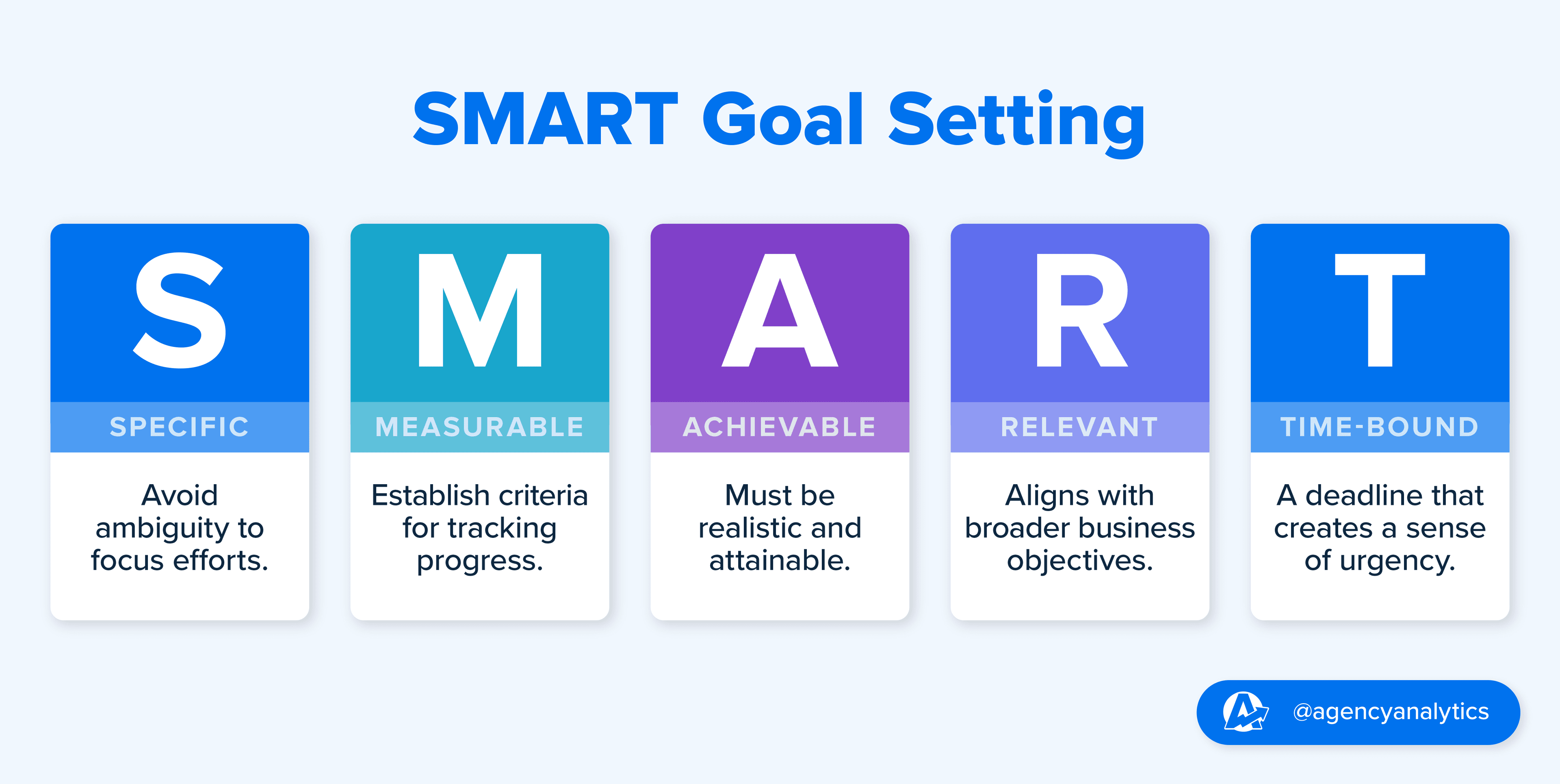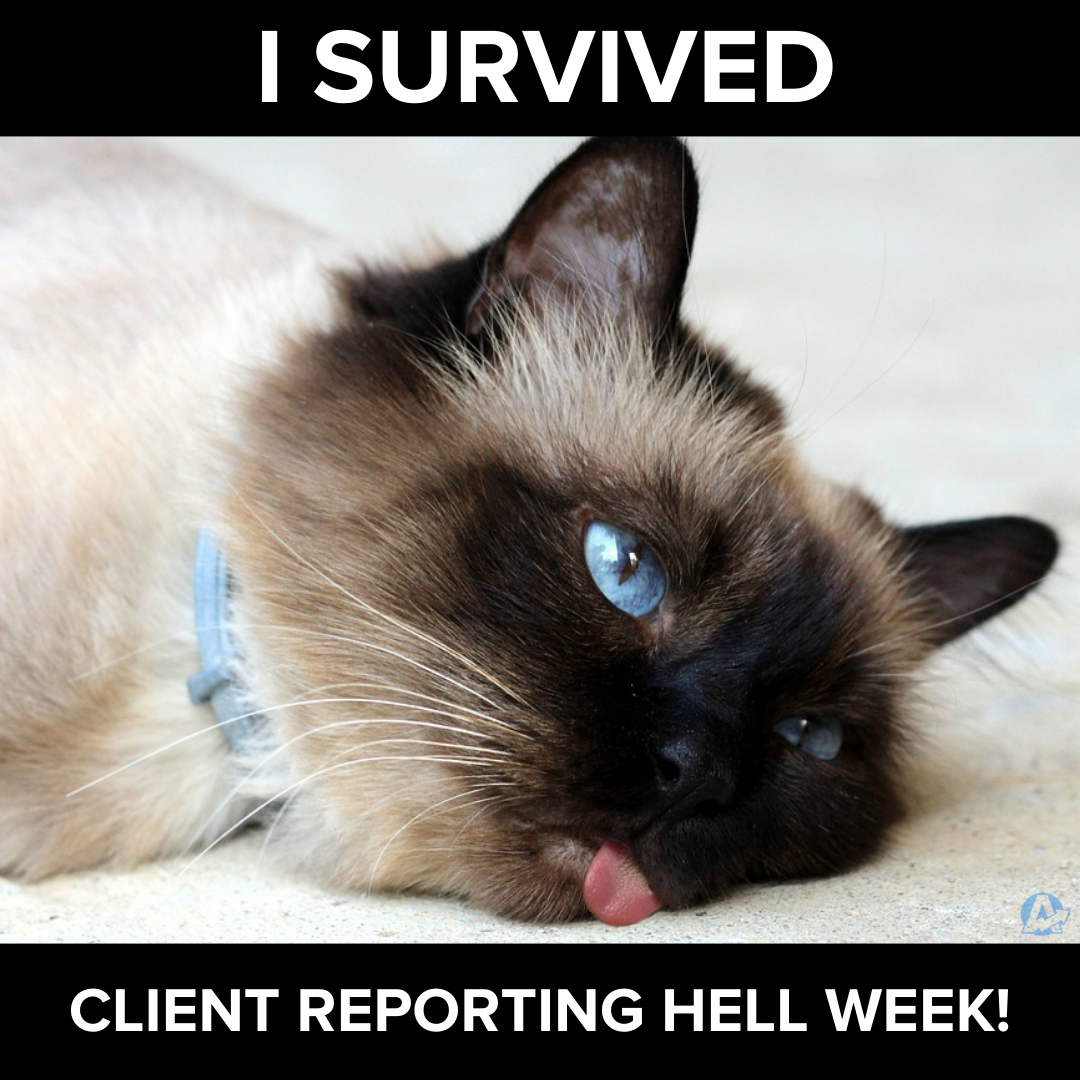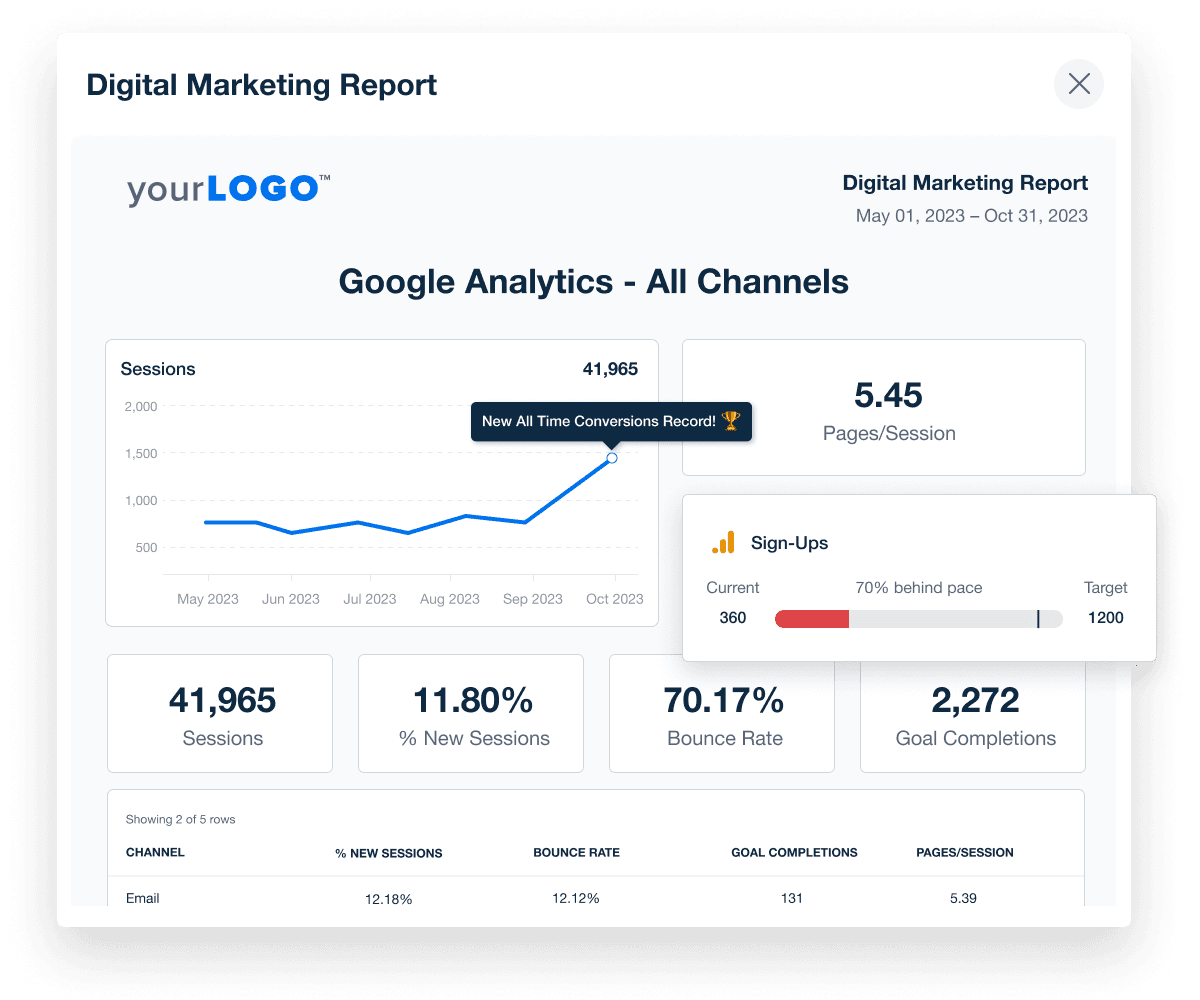Table of Contents
QUICK SUMMARY:
SMART goals, known for being Specific, Measurable, Achievable, Relevant, and Time-bound, have long guided marketing agencies. However, the MASTER goals framework—Measurable, Achievable, Specific, Transforming, Evolving, Relevant—offers a more adaptive structure. This approach addresses the evolving challenges marketing agencies face, helping them set flexible yet precise goals for continuous growth. Learn more about the benefits of MASTER goals and how to implement them.
Goal setting is a vital part of any agency’s business strategy or your own personal development plan. It's how we outline our path to success, track progress, and keep ourselves accountable.
For many years, SMART goals have been a popular goal framework: Specific, Measurable, Achievable, Relevant, and Time-bound.
But it's time for a fresh approach.
Picture this: An owner at a bustling marketing agency sits down to draft SMART goals for the upcoming quarter. The SMART framework has always been their agency’s tried-and-true recipe for future success.
But this year, as the agency owner tries to pin down their specific objectives, they feel a nagging sense that the old recipe just doesn't seem to fit the new, complex flavor of the agency’s landscape.
It's as though they're attempting to make a gourmet meal but are constrained by the basic ingredients from an outdated pantry. The agency's needs are evolving, clients are demanding more, and the traditional SMART criteria suddenly feel too rigid and basic.
While the SMART framework has its merits, the complexities faced by today’s expanding agencies require a goal-setting framework that can evolve to meet their needs. Something more agile and adaptive, something that resonates with the pulse of today's fast-paced business environment.
MASTER Your Agency's Goals
The MASTER acronym stands for Measurable, Achievable, Specific, Transforming, Evolving, and Relevant. It's a method designed to align with contemporary needs, and it's set to provide a more adaptable and nuanced way to chart agency goals.

If your agency is looking to energize your goal-setting process and find a flexible yet precise way to map out your future success, MASTER goals offer a steady path forward.
To understand why your agency should create MASTER goals, let’s first take a look at the road traveled so far with SMART and why it might be time for a change.
Understanding the SMART Goals Framework
Dating back to the early 1980s when it was introduced by George T. Doran, the SMART goal framework is a widely used tool in business planning and personal development that emphasizes clear, measurable objectives. It provides a structured approach to goal setting by ensuring that goals are Specific, Measurable, Achievable, Relevant, and Time-bound. But, like any tool, it has its benefits and limitations.
The adoption of the SMART framework represented a shift from vague aspirations to actionable goals, making it a cornerstone of modern management practices. Sort of like how the first cell phones transformed communications–but you don’t see people lugging around those massive bricks anymore.
Breakdown of SMART Goal Criteria
Here's a closer look at the five building blocks of the SMART acronym, each essential in crafting goals that lead to real, tangible results:
Specific: Goals must be clear and specific, avoiding ambiguity. This helps in focusing efforts and clearly defining what needs to be achieved. No vague goals allowed!
Measurable: A goal must have criteria that allow for tracking progress and determining success. This often involves numbers or specific milestones.
Achievable: Realistic goals should be attainable without Herculean efforts and not so far-fetched that they become demotivating.
Relevant: A relevant goal must align with broader business objectives or personal values to ensure they contribute to overall success.
Time-bound: Having a deadline to achieve goals creates a sense of urgency and keeps the focus on moving forward.

The SMART framework's structured approach made it popular in various contexts, from project management to personal development. Some benefits include:
Providing a clear roadmap for achieving objectives
Enabling progress tracking and accountability
Enhancing communication and understanding among team members
Facilitating alignment with organizational goals
Those are just a few of the reasons why its application currently spans across industries, including marketing, healthcare, education, and more.
Limitations of SMART Goals
Despite its widespread use, the SMART goal framework is not without its critics. Some limitations when you write smart goals include:
Lack of flexibility to adapt to changing circumstances
Potential overemphasis on short-term achievements at the expense of long-term vision
Risk of becoming too rigid or formulaic, stifling creativity
May not adequately address the emotional or motivational aspects of goal-setting
These limitations have led some to seek alternatives–including the MASTER goals framework– to better align with the dynamic and multifaceted needs of agencies and their leaders.
In the end, while the SMART goal framework has served as a valuable tool for a long time, its structure and approach may not suit every situation or need–especially at a marketing agency.
Using MASTER Goals as an Alternative to SMART Goals
MASTER goals offer an exciting advancement in goal-setting theory that resonates better with agencies or individuals aiming for continuous growth. While reminiscent of the well-known SMART goals, MASTER adds new dimensions that are adaptable, forward-thinking, and aimed at fostering a more motivating and dynamic approach to reaching personal and career goals.
Breakdown of MASTER Goals Criteria
You’ll recognize some familiar elements, but the MASTER structure pivots slightly to emphasize an adaptable and data-backed approach to today’s business environment. Here's a detailed breakdown of the six building blocks that make up the MASTER acronym.
Measurable: Unlike other goals that might be vague, MASTER emphasizes a trackable approach. This means setting benchmarks and using concrete metrics to gauge progress. Think of it as having mile markers along the road to the ideal future.
Achievable: An achievable goal is realistic and attainable within a set time frame. It's neither too easy nor impossibly hard, but rather something that stretches abilities without breaking them.
Specific: A goal specific in nature outlines exactly what needs to be achieved–and by when–leaving no ambiguity. It sets the stage for a focused effort, where everyone knows exactly what the target is.
Transforming: Goals should be designed to bring about significant change or improvement. This component adds fuel to the goal-setting fire. Transformative goals inspire and energize, acting as a driving force that keeps people engaged and eager to push forward.
Evolving: Goals should not be static. The 'E' in MASTER stands for evolving, recognizing that goals might need to adapt and grow as circumstances change. This is a nod to the fluidity of life and business, ensuring that the goal meets current needs and priorities.
Relevant: Setting relevant goals ensures alignment with the broader objectives and values of the agency. It helps keep the goal in sync with the direction of the team or individual, ensuring that they don’t waste time on irrelevant pursuits.
Advantages of MASTER Over SMART
MASTER goals offer a refreshing alternative to traditional goal-setting methods. This dynamic, adaptive, and human-centric approach holds great promise for those seeking a goal-setting framework that outlines clear and achievable targets and keeps pace with the ever-changing context of life and business.
Emphasis on Evolution: Unlike SMART goals, which can be rigid, MASTER encourages an adaptable and evolving approach. It acknowledges that goals may need to change over time, making them malleable and more aligned with real-world dynamics.
Incorporates Motivation: While SMART provides a logical framework, MASTER adds an emotional component with its focus on motivation. This caters to the human element, which is crucial in maintaining momentum toward goals, especially when challenges arise.
Broader Application: MASTER can be applied to personal and career goals, making it a versatile framework. Whether an agency is aiming for growth or an individual is targeting personal development, MASTER's adaptability makes it applicable to various scenarios.
Alignment with Values: The relevance aspect of MASTER ensures that the goal-setting process aligns with broader values and objectives. This makes the pursuit of the goal more meaningful and satisfying, as it's tied to the bigger picture.
MASTER goals are like having a GPS system that recalculates the route as you drive, ensuring that no matter what detours or roadblocks come up, you still reach your destination.
How To Create MASTER Goals
Creating MASTER goals is a systematic and thoughtful process requiring attention to detail, alignment with broader objectives, and an understanding of what motivates and drives growth. Here's a step-by-step guide to crafting effective MASTER goals for personal or business development:
Step 1: Identify the Measurable Goal
Begin by pinpointing exactly what you want to achieve. Defining how you'll measure progress toward the goal provides clarity during the goal-setting process. Establish benchmarks or key performance indicators (KPIs) that will allow you to track how close or far you are from reaching the goal.
Whether you are creating goals for your agency or for clients, tie the goals back to specific measurables so you have a clear view of the progress being made.

Goal tracking can be used for both clients and the agency. Get started with AgencyAnalytics today by signing up for your Free Trial.
Step 2: Assess Achievability
Make sure the goal is realistic and attainable. Achievable goals are part of many goal frameworks because setting impossible goals–although aspirational–can be very demotivating. Break it down into smaller, manageable tasks if necessary, and set clear milestones with a target date or completion date.
If your agency is following more of an OKR framework, where you are shooting for the moon, but you’re okay if you miss and end up among the stars, just make sure the team knows where the mile marker of success lies.
Step 3: Focus on Specificity
When setting goals, vagueness is your enemy. Be clear and concise, leaving no room for ambiguity. For instance, "Increase sales by 20% in the next quarter" is more specific than "Increase sales."
Crafting your MASTER goals means thinking as specifically as possible. What exactly do you want to achieve? Break it down into measurable elements and set a realistic but challenging time frame for reaching it. This will guide your action plan and keep the whole team on the same page as you move toward your objective.
Step 4: Add Motivation Through Transformation
Infuse the goal with an emotional component that drives engagement. Identify what makes this goal exciting and how it aligns with personal or business growth. Or, demonstrate how achieving the goal will help your team avoid existing pain points that are currently causing frustrations.
For example, if your account managers are tired of client reporting hell week, a goal to transform reporting processes and reduce reporting time by 50% might be a great motivator.

Step 5: Build in Evolution
Goals must adapt over time. Consider potential changes in circumstances and how the goal can evolve to remain meaningful and attainable as new challenges arise. This doesn’t mean goals can default to being nebulous, they still need to be concrete. For example, if your target is to bring in 20 new clients, but you end up landing an enterprise SEO agreement, that target may need to change because you no longer have the resources to support 19 smaller clients and one enterprise client.
Step 3: Confirm Relevance
Align the goal with your agency’s overall mission, values, or business strategy. If the goal doesn't fit with what you're overall aiming for, it might waste time without adding value to your main objectives.
This comes up fairly often when agencies are debating between buying vs. building a client reporting platform. While building your own reporting platform may seem like the best option for customization and flexibility, many agencies soon discover that the effort required to build zaps resources from other, more important priorities without adding much value to the bottom line.
Step 7: Review and Adjust
Regularly review progress and make necessary adjustments. Goals are not set in stone, and the MASTER Goals framework recognizes the need for flexibility and continuous alignment.
For a marketing agency utilizing MASTER goals, the best cadence for reviewing these goals will depend on the nature of the projects and the dynamic nature of the industry. However, a general guideline can be as follows:
Weekly Check-Ins: A brief review to ensure that short-term actions align with the goals. This is more about staying on track rather than reassessing the goals themselves. 1-on-1 meetings are a great opportunity to reality-check the MASTER goals.
Monthly Reviews: A more in-depth examination to assess if the goals are still Specific, Trackable, Relevant, Evolving, Achievable, and Motivating. This is a time to make minor tweaks and ensure alignment with ongoing campaigns or client needs.
Quarterly Assessments: A comprehensive review to see if any significant shifts in the market, agency direction, or client demands necessitate a more substantial reevaluation or modification of the goals. If you're used to doing quarterly planning, this easily becomes part of that process.
Annual Review and Planning: A holistic view of the year to analyze successes, failures, and areas for improvement. This provides an opportunity to set new MASTER goals for the upcoming year.
Remember, the "Evolving" part of MASTER goals emphasizes adaptability. In a rapidly changing field like digital marketing, there might be times when an unexpected shift requires an unscheduled review. Keep a finger on the pulse of the industry, and don't be afraid to revisit these goals whenever necessary.
Template for MASTER Goal Setting
Criteria | Description | Example |
|---|---|---|
Measurable | Identify measurable metrics and benchmarks to track progress | Track weekly survey results, NPS scores and monthly overall scores such as Customer Satisfaction Score (CSAT). |
Achievable | Set a realistic target that stretches abilities without being impossible | Achieve a 1% improvement each week to allow for at least a few weeks where the overall rating plateaus or dips. |
Specific | Clearly define what you want to achieve and the time frame for reaching the goal | Increase customer satisfaction rating by 10 points in the next 6 months. |
Transforming | The goal will bring about significant change or improvement | Reach a customer satisfaction rating we can all brag about, which will also lead to improved client retention and revenue growth. |
Evolving | Acknowledge that goals may change and adapt as needed | Review monthly and adapt strategies as customer feedback and market conditions change. |
Relevant | Ensure alignment with broader personal or business objectives | Improving customer service response time will increase retention rates and help drive the agency’s bottom line. |
With the above instructions and template, creating MASTER goals becomes a structured yet adaptable process. Whether aiming for personal milestones or steering an agency toward success, the MASTER framework offers a refreshing approach to setting meaningful and resonant goals.

Quickly and easily integrate goal tracking for your agency and your clients. Try AgencyAnalytics free for 14 days!
Summary and Key Takeaways
The process of setting goals is integral to achieving success, both in personal growth and business development. Whether you're striving for attainable personal goals or laying out a road map for an entire team, the right framework can make all the difference.
Here's a recap of the vital insights to guide you toward your finish line:
Understand the various frameworks: Different goal-setting frameworks cater to different needs. From the classic SMART to the adaptive MASTER goals, understanding these frameworks helps you craft relevant and attainable goals.
Embrace MASTER goals: As an alternative to SMART, MASTER goals offer a comprehensive approach that considers the changing dynamics of goals without being vague or ambiguous.
Remember that it’s a team effort: Ensuring the whole team is on the same page is key. Whether setting team goals or individual objectives, clear understanding and collaboration among team members are crucial.
Align goals with the big picture: Don't lose sight of the overall objective. Similar to the EOS rocks framework, all smaller goals should align with the bigger picture and steer everyone in the right direction.
Make goals measurable: What gets measured gets managed. Defining measurable goals–along with the relevant KPIs and metrics–helps you track progress and makes it possible to adapt and accomplish.
Implement an action plan: Planning and executing an effective action plan ensures that you set goals that are more than just words on paper. It helps you put your best foot forward in the direction of the finish line.
Keep evolving: Goals should not be set in stone. By adapting to changes and staying flexible in your approach, you stay relevant despite what the world throws at you.
Setting goals helps in breaking down complex objectives into smaller, more manageable parts. It gives direction, fosters accountability, and allows you to track progress toward what's truly important.
Whether personal or professional, the journey towards achieving important goals is filled with learning and growth. By understanding the landscape and choosing the right framework, you embark on this journey with confidence and clarity. So gear up, set those goals, and step forward into a future of possibilities.

Written by
Paul Stainton is a digital marketing leader with extensive experience creating brand value through digital transformation, eCommerce strategies, brand strategy, and go-to-market execution.
Read more posts by Paul StaintonSee how 7,100+ marketing agencies help clients win
Free 14-day trial. No credit card required.





